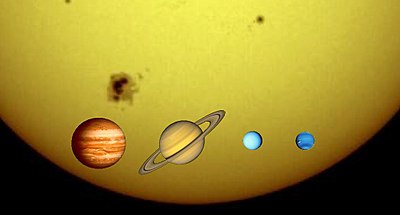Main article: Solar System
See also: List of gravitationally rounded objects of the Solar System
According to the IAU's current definitions, there are eight planets and five dwarf planets in the Solar System. In increasing distance from the Sun, the planets are:Jupiter is the largest, at 318 Earth masses, while Mercury is smallest, at 0.055 Earth masses.
The planets of the Solar System can be divided into categories based on their composition:
- Terrestrials: Planets that are similar to Earth, with bodies largely composed of rock: Mercury, Venus, Earth and Mars. At 0.055 Earth masses, Mercury is the smallest terrestrial planet (and smallest planet) in the Solar System, while Earth is the largest terrestrial planet.
- Gas giants (Jovians): Planets largely composed of gaseous material and significantly more massive than terrestrials: Jupiter, Saturn, Uranus, Neptune. Jupiter, at 318 Earth masses, is the largest planet in the Solar System, while Saturn is one third as big, at 95 Earth masses.
- Ice giants, comprising Uranus and Neptune, are a sub-class of gas giants, distinguished from gas giants by their significantly lower mass (only 14 and 17 Earth masses), and by depletion in hydrogen and helium in their atmospheres together with a significantly higher proportion of rock and ice.
- Dwarf planets: Before the August 2006 decision, several objects were proposed by astronomers, including at one stage by the IAU, as planets. However in 2006 several of these objects were reclassified as dwarf planets, objects distinct from planets. Currently five dwarf planets in the Solar System are recognized by the IAU: Ceres, Pluto, Haumea, Makemake and Eris. Several other objects in both the Asteroid belt and the Kuiper belt are under consideration, with as many as 50 that could eventually qualify. There may be as many as 200 that could be discovered once the Kuiper belt has been fully explored. Dwarf planets share many of the same characteristics as planets, although notable differences remain – namely that they are not dominant in their orbits. By definition, all dwarf planets are members of larger populations. Ceres is the largest body in the asteroid belt, while Pluto, Haumea, and Makemake are members of the Kuiper belt and Eris is a member of the scattered disc. Scientists such as Mike Brown believe that there may soon be over forty trans-Neptunian objects that qualify as dwarf planets under the IAU's recent definition.[73]



0 comments:
Post a Comment